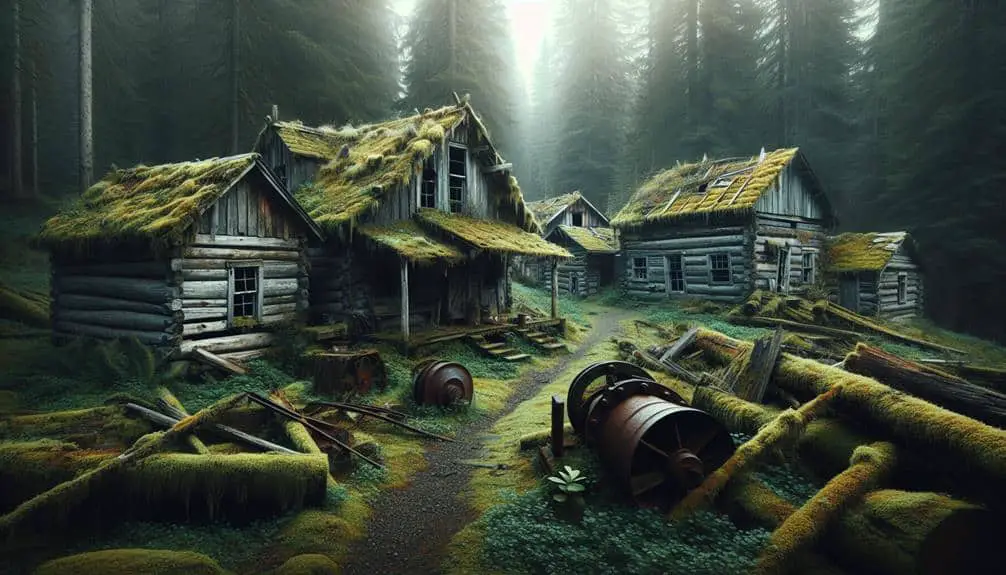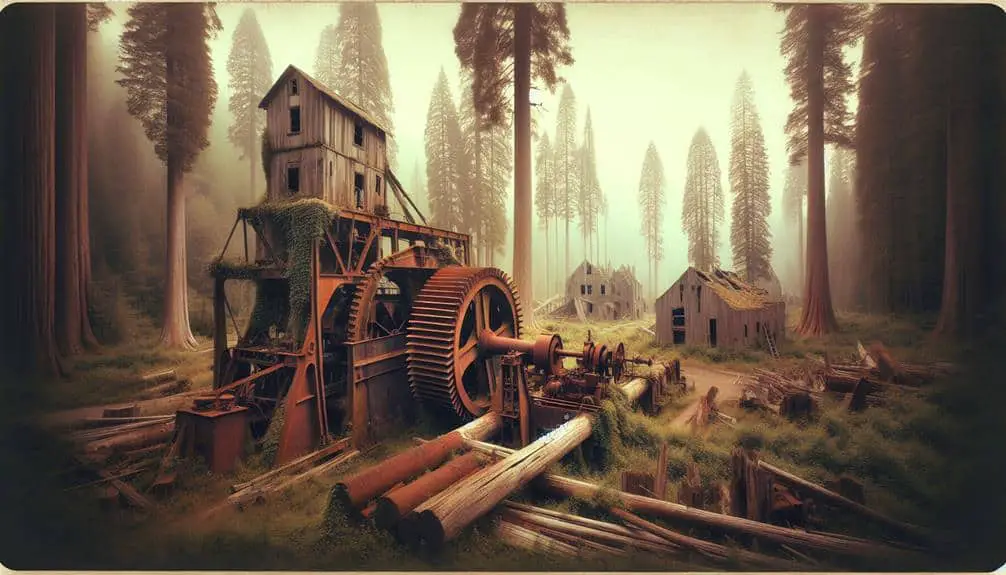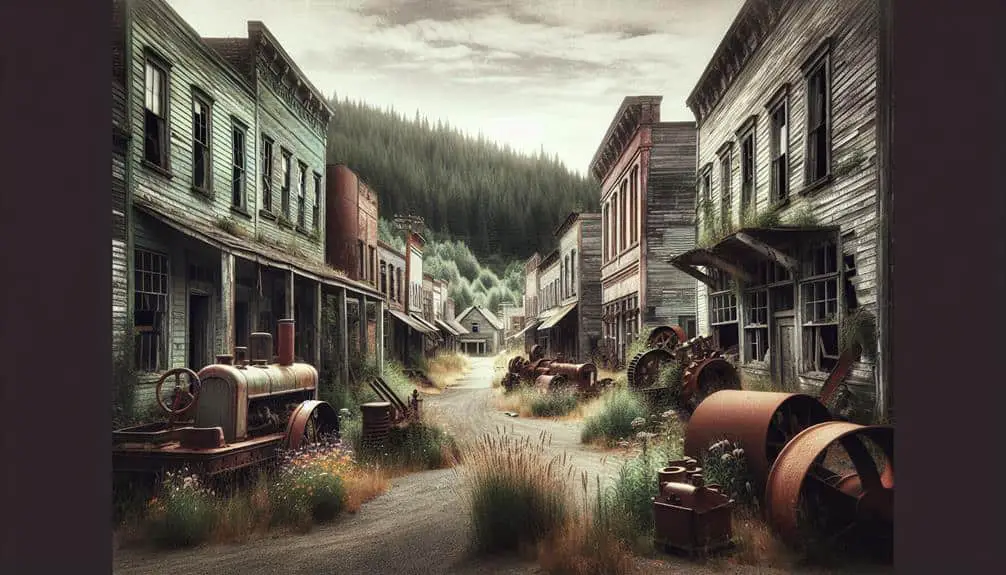Explore the forgotten timber camp ruins scattered across the US. Nestled in dense forests, these sites pose preservation challenges due to their remote locations. In the Pacific Northwest, witness the environmental impact on soil and wildlife, steeped in historical significance and cultural heritage. Experience the haunting tales surrounding Appalachian abandoned structures, with echoes of bustling days lingering. Discover the artifacts offering glimpses into the past in the Midwest, telling stories of resilience and determination. The rocky mountains showcase industry relics like rusting machinery and decaying cabins. Each ruin holds a unique tale waiting to be unraveled.
Key Points
- Abandoned structures in Pacific Northwest
- Haunting tales of Appalachian ruins
- Midwest artifacts reveal past lives
- South's timber logging history
- Rocky Mountains' loggers' legacy insights
Pacific Northwest Timber Camp Ruins
Nestled deep within the dense forests of the Pacific Northwest lie the eerie remnants of timber camp ruins, a haunting reminder of the region's industrial past. These sites pose significant preservation challenges due to their remote locations and exposure to the elements. The environmental impact of these abandoned camps is palpable, with issues such as decaying structures leaching chemicals into the soil and impacting local wildlife.
Despite the challenges, these timber camp ruins hold immense historical significance and are an essential part of the region's cultural heritage. They serve as tangible links to a bygone era when logging was a primary industry in the Pacific Northwest, shaping the landscape and communities in profound ways. Preserving these sites is necessary not only for honoring the laborers who toiled in these camps but also for educating future generations about the region's rich history.
Efforts to safeguard and interpret these ruins are critical to maintaining the connection to the past and understanding the impact of industrialization on the environment. Balancing preservation with environmental concerns is key to ensuring that these sites endure as poignant reminders of a pivotal chapter in the Pacific Northwest's history.
Appalachian Timber Camp Ghost Towns
Exploring the Appalachian region reveals the haunting remnants of timber camp ghost towns, silent witnesses to a bygone era of industrial activity and community life. These Appalachian timber camp ghost towns are steeped in history, with each abandoned structure telling a story of the past. Haunted tales often surround these forgotten relics, adding to their mystique and intrigue. As you wander through the overgrown paths and dilapidated buildings, you can't help but feel a sense of nostalgia for the bustling days when these towns were alive with the sounds of sawmills and the chatter of workers.
The Appalachian timber camp ghost towns stand as a reminder of the transient nature of industry and the communities it once sustained. Amidst the quietude, echoes of the past whisper through the rustling leaves and creaking timbers. Each decaying building holds secrets of lives lived and dreams abandoned, inviting you to piece together the fragments of history scattered across the forest floor. Embrace the eerie beauty of these ghost towns, where time stands still, and the spirits of the past linger in the shadows.
Rustic Timber Camp Remnants in the Midwest
Amidst the rolling landscapes of the Midwest, remnants of rustic timber camps silently bear witness to a bygone era of labor and community life. These sites, scattered throughout the region, hold a treasure trove of timber camp artifacts that offer a glimpse into the past.
The Midwest played an important role in the logging industry evolution, with these camps serving as hubs for logging operations, housing workers and their families, and fostering a sense of camaraderie among the labor force.
Exploring these remnants allows you to step back in time and appreciate the hardships and triumphs of those who toiled in the forests. From simple cabins to old tools and equipment, each artifact tells a story of resilience and determination. The logging industry's evolution in the Midwest shaped not only the landscape but also the communities that emerged around these timber camps.
As you wander through these silent witnesses of the past, take a moment to reflect on the lives lived and the legacy left behind by those who helped build the foundation of the region.
Abandoned Timber Logging Sites in the South
Explore the rich history of timber logging in the Southern United States, where vast forests once echoed with the sounds of saws and axes.
Consider the lasting impact of this industry on the environment, from deforestation to habitat disruption.
Discover ongoing efforts to preserve what remains of these abandoned logging sites, highlighting the importance of conservation and historical awareness in the region.
Southern Timber Logging History
In the Southern United States, numerous abandoned timber logging sites bear witness to a bygone era of relentless forestry activities. Timber camp architecture in the region often comprised simple wooden structures for housing loggers, mess halls, and storage buildings. These camps were strategically located near the logging sites to minimize transportation distances for the harvested timber.
Timber logging techniques in the South ranged from traditional hand tools like axes and crosscut saws to more mechanized approaches with steam-powered equipment in the later years. The use of railroads and rivers facilitated the transportation of logs to sawmills, marking a significant advancement in the efficiency of the timber industry.
Exploring these abandoned sites provides a glimpse into the rich history of timber logging in the Southern United States.
Impact on Environment
The legacy of abandoned timber logging sites in the Southern United States reveals a complex interplay between human activity and the natural environment, shedding light on the lasting impact of past forestry practices.
The environmental impact of these abandoned sites is profound, disrupting ecosystems and hindering natural processes. Ecosystem recovery in these areas faces significant challenges, as deforestation can lead to soil erosion, loss of biodiversity, and alteration of habitats.
Conservation efforts and the adoption of sustainable practices are essential to mitigate these effects and restore balance to these damaged landscapes. By implementing responsible forestry management and reforestation initiatives, there's hope for these areas to heal and thrive once again, showcasing the resilience of nature when given the chance to regenerate.
Preservation Efforts Today
Amid the remnants of forgotten timber camp ruins in the Southern United States lies a concerted effort to safeguard and rehabilitate these historic sites for future generations.
Preservation challenges such as weathering, vandalism, and lack of funding have hindered progress, but community involvement has been instrumental in tackling these obstacles.
Sustainable restoration methods are being employed to guarantee that the sites aren't only preserved but also environmentally friendly.
The historical significance of these timber logging sites can't be overstated, as they offer a glimpse into the region's past and the importance of the timber industry.
Forgotten Lumber Camp Ruins in the Northeast
Nestled within the dense forests of the Northeast lie the forgotten ruins of lumber camps, remnants of a bygone era when the timber industry thrived in these rugged terrains. Heritage preservation enthusiasts and industrial archaeologists find these sites intriguing, offering a glimpse into the past when these camps bustled with activity. These camps, once vibrant with the sounds of sawing and machinery, now stand as silent witnesses to a once-booming industry.
Exploring these abandoned lumber camps reveals a rich history of hard work, resilience, and the challenges faced by those who toiled in the forests. The decaying cabins, rusted tools, and overgrown trails paint a vivid picture of the harsh conditions endured by the workers who harvested timber in these unforgiving landscapes.
While these ruins may seem forgotten, they hold immense value in understanding the region's industrial heritage. Preserving these sites not only honors the laborers who contributed to the timber industry but also provides a unique opportunity for modern-day explorers to connect with the past. The Northeast's lumber camp ruins serve as tangible reminders of a bygone era, waiting to be rediscovered and appreciated for their historical significance.
Timber Industry Relics in the Rocky Mountains
As you explore the Timber Industry Relics in the Rocky Mountains, you'll encounter remnants of Rocky Mountain logging sites, offering a glimpse into the region's rich history of timber harvesting. Abandoned sawmills dotting the landscape serve as silent witnesses to the once-thriving timber industry that shaped the rugged terrain.
These relics provide a tangible link to the past, inviting you to uncover the stories of the laborers and communities that depended on the timber trade for their livelihood.
Rocky Mountain Logging Sites
Numerous logging sites scattered throughout the Rocky Mountains stand as enduring remnants of the timber industry's historical presence in the region. These sites are rich in timber camp artifacts, offering a glimpse into the lives of loggers who toiled in these rugged terrains.
Rusting machinery, decaying cabins, and overgrown rail tracks are just a few examples of the logging industry relics that can be discovered amidst the mountainous landscapes. Each site tells a story of hard work, perseverance, and the challenges faced by those who sought to harvest timber in these remote areas.
Exploring these Rocky Mountain logging sites provides a unique opportunity to connect with the past and appreciate the sacrifices made in shaping the timber industry of the region.
Abandoned Sawmills Discovery
Exploring the remnants of Rocky Mountain logging sites reveals a treasure trove of abandoned sawmills, showcasing the enduring legacy of the timber industry in the region. These forgotten logging communities left behind a rich tapestry of history, with timber camp artifacts scattered throughout the landscape.
The discovery of these abandoned sawmills offers a glimpse into the past, highlighting the crucial yet indispensable role they played in shaping the Rocky Mountains. The rusted machinery, decaying structures, and overgrown paths paint a vivid picture of a bygone era when the timber industry flourished in these rugged terrains.
Unearthing these relics provides a unique opportunity to appreciate the resilience and ingenuity of those who once toiled in these remote forests, leaving behind a lasting imprint on the land.
Derelict Timber Camps in the Great Lakes Region
Countless derelict timber camps stand as haunting reminders of the once-thriving logging industry in the Great Lakes Region. The architecture of these camps varies from simple log cabins to more elaborate structures that housed loggers and their families. Walking through these abandoned camps, you can almost hear the echoes of forgotten logging stories, tales of hard work, camaraderie, and the challenges faced in the harsh wilderness.
The timber camp architecture often reflects the rugged lifestyle of the loggers, with sturdy buildings built to withstand the harsh winters and provide a sense of home in the wilderness. Many of these camps were self-sustaining communities, with their own schools, churches, and general stores, creating a unique microcosm in the vast forests of the Great Lakes Region.
Exploring these derelict timber camps offers a glimpse into a bygone era, where people lived in harmony with nature, relying on their skills and resourcefulness to survive. These camps serve as poignant reminders of the human impact on the environment and the transient nature of industry in the face of changing times.
Historic Timber Settlements in the Southwest
The historic timber settlements in the Southwest boast a unique charm, with their well-preserved structures telling stories of a bygone era.
These settlements hold great cultural significance today, providing insight into the region's rich history and the people who once inhabited these areas.
Exploring these sites offers a window into the past, showcasing the craftsmanship and resilience of those who built and lived in these timber communities.
Southwest Timber Settlements
Nestled among the rugged terrain of the Southwest lie the remnants of historic timber settlements, echoing the once bustling industry that shaped the region.
Timber camp architecture in the Southwest often featured sturdy log cabins, built to withstand the harsh desert climate. These settlements, with their simple yet functional designs, served as homes for workers and their families during the peak of the timber industry.
The economic impact of these settlements was profound, providing employment opportunities and driving local economies. Timber was a valuable resource, fueling the growth of towns and cities in the region.
The legacy of these timber settlements serves as a reminder of the resilience and ingenuity of those who contributed to the development of the Southwest.
Unique Historic Structures
Echoing the legacy of the once vibrant timber settlements in the Southwest, the unique historic structures stand as proof to the ingenuity and craftsmanship of a bygone era.
Timber camp architecture in this region often featured sturdy log cabins, barns, and other structures meticulously crafted from local wood. These forgotten logging communities thrived on the hard work and resilience of their inhabitants, leaving behind a tangible reminder of their existence in the form of these structures.
The design of these buildings reflected both functionality and a sense of community, with shared spaces for meals and gatherings. Exploring these historic sites allows for a glimpse into the past and an appreciation of the labor and skill that went into creating these enduring monuments of a bygone time.
Cultural Significance Today
Have you ever pondered the enduring cultural significance of the historic timber settlements in the Southwest?
These settlements hold a deep connection to indigenous communities, serving as reminders of their rich heritage and traditional way of life.
The timber camps not only provided economic opportunities but also facilitated cultural exchange and cooperation between different groups.
Today, the remnants of these settlements stand as affirmations to the resilience and ingenuity of those who called them home.
The economic impact of these settlements reverberates through time, shaping the region's development and influencing modern industries.
Timber Towns Left to Decay in the Southeast
In the southeastern United States, numerous timber towns now stand deserted and decaying, remnants of a bygone era of prosperity and industrial activity. The timber industry decline in the region has left behind a trail of forgotten history and cultural heritage, with these once-thriving towns now serving as eerie reminders of their past significance. As you wander through these decaying settlements, you can witness the environmental impact of the timber industry's rise and fall. Nature slowly reclaims the land, intertwining with the remnants of human activity, creating a hauntingly beautiful yet somber atmosphere.
The decaying structures, overgrown with vegetation, evoke a sense of nostalgia for a time when these towns buzzed with life and productivity. The abandoned sawmills, empty worker residences, and dilapidated storefronts all tell a story of economic shifts and changing landscapes. Exploring these timber towns offers a glimpse into a forgotten chapter of American history, where the echoes of the past mingle with the sounds of nature reclaiming its territory.
Vanishing Timber Camps Across the US
As timber camps disappear across the US, a narrative of loss and transformation unfolds in the wake of the logging industry decline. These camps, once bustling hubs of activity in the heart of forests, now stand as relics of a bygone era, slowly succumbing to nature's reclamation. The timber camp architecture, characterized by sturdy log cabins, communal mess halls, and rugged outbuildings, serves as a poignant reminder of the labor and lives intertwined with the land.
The decline of the logging industry has led to the abandonment of these once-thriving camps, leaving behind a haunting emptiness that echoes through the trees. As machines replaced manual labor and environmental concerns shifted focus, the camps fell into disuse, their structures weathering away under the weight of time. Yet, amid the decay, there's a sense of resilience in these vanishing timber camps, a demonstration to the cyclical nature of industries and the enduring spirit of those who once called these remote outposts home.
Frequently Asked Questions
Are There Any Efforts Being Made to Preserve or Restore These Forgotten Timber Camp Ruins?
Efforts are underway to preserve and restore these forgotten timber camp ruins. Preservation initiatives focus on documenting history, while restoration projects aim to revive structures. Your backing can ensure these sites remain for future generations.
What Kind of Equipment and Tools Were Used in These Timber Camps in the Past?
In the past, workers at timber camps used various types of equipment such as axes, saws, peaveys, and crosscut saws. These logging tools were essential for felling trees, cutting logs, and moving timber efficiently.
Are There Any Legends or Folklore Associated With the Timber Camp Ghost Towns?
You'll find an abundance of haunting tales and local legends surrounding these ghost towns. Spooky sightings and ghost stories have been passed down through generations, adding an air of mystery to these forgotten timber camp ruins.
How Did the Decline of the Timber Industry Contribute to the Abandonment of These Logging Sites in the South?
The decline of the timber industry had a significant impact on the abandonment of logging sites in the south. It led to economic downturns, job losses, and environmental consequences like deforestation and habitat destruction.
Are There Any Safety Concerns for Visitors Exploring These Derelict Timber Camps in the Great Lakes Region?
When exploring derelict timber camps in the Great Lakes region, visitor safety is paramount. Hazards like unstable structures and the presence of wildlife pose risks. Preservation efforts balance historical significance with ensuring a safe experience for all.



